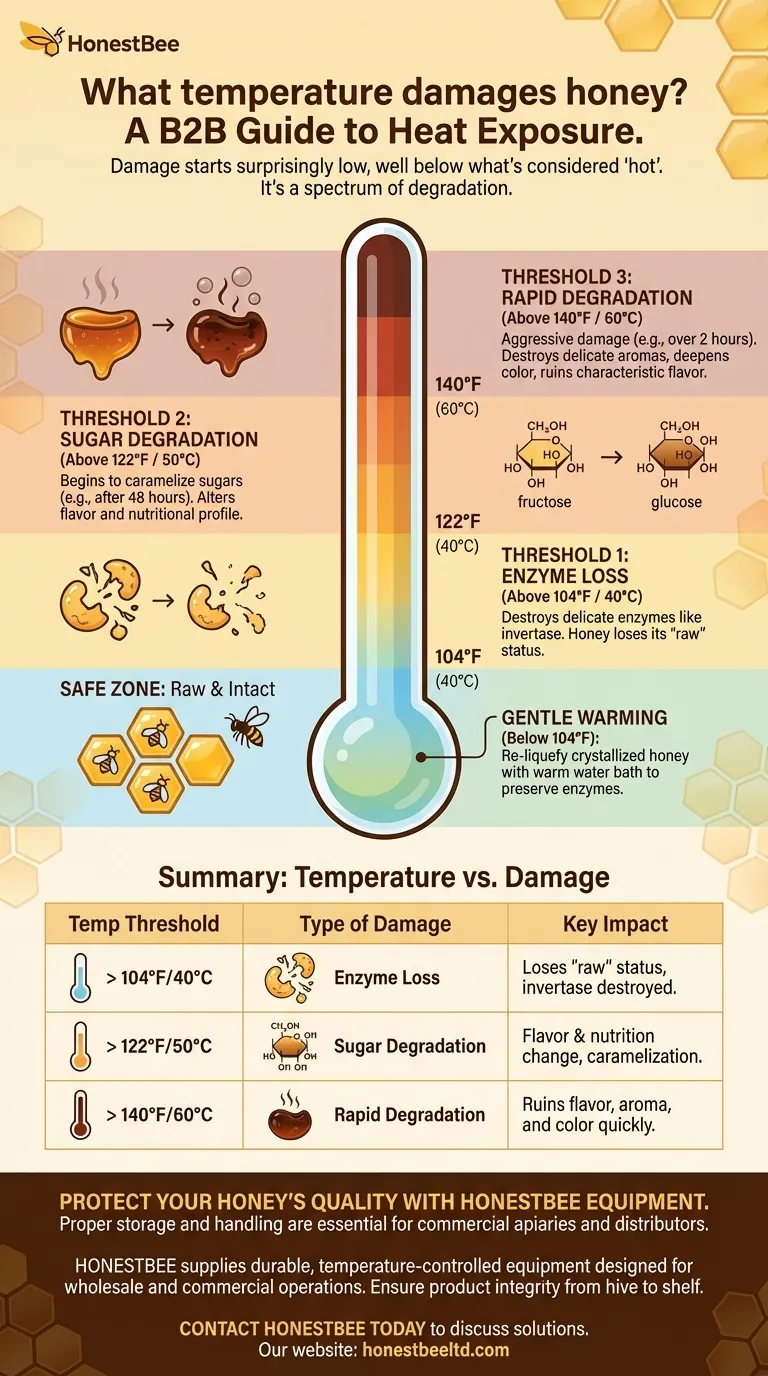The short answer is that damage to honey begins at a surprisingly low temperature, well below what most people would consider "hot." The specific type and severity of damage are a direct result of both the temperature reached and the duration of the exposure. Even modest warmth can begin to degrade its beneficial properties.
The core principle to understand is that honey damage isn't a single event but a spectrum. It starts with the loss of delicate enzymes around 104°F (40°C) and progresses to the degradation of unique sugars and flavors at higher temperatures.

The Spectrum of Heat Damage in Honey
The idea that honey is either "good" or "damaged" is a misconception. In reality, heat affects its components progressively, with different properties being lost at different thresholds.
The First Threshold: Enzyme Loss (Above 104°F / 40°C)
The most sensitive components in raw honey are its enzymes, such as invertase. This enzyme is added by bees and plays a role in the honey's unique composition.
Heating honey above 104°F (40°C) is enough to destroy this important enzyme. This is the temperature at which honey loses its technical status as a "raw" food.
The Second Stage: Sugar Degradation (Above 122°F / 50°C)
As temperatures rise, the very sugars that make honey unique begin to change.
Heating honey to 122°F (50°C) for an extended period (like 48 hours) begins to caramelize its valuable fructose and glucose. This process alters the honey's flavor and nutritional profile, making it more akin to a simple sugar syrup.
The Final Stage: Rapid Degradation (Above 140°F / 60°C)
At this level, the damage becomes much more aggressive and happens far more quickly.
Exposing honey to temperatures above 140°F (60°C) for more than two hours will cause rapid and significant degradation. This level of heat destroys most of its delicate aromas, deepens its color, and can fundamentally ruin its characteristic flavor.
Understanding the Trade-offs: Liquefying vs. Cooking
Given these low damage thresholds, the obvious question is why anyone would intentionally heat honey. The primary reason is to manage its natural tendency to crystallize.
The Challenge of Crystallization
Crystallization is a natural process where glucose separates from the water in honey. It is not a sign of spoilage, but it does make the honey difficult to use.
Gentle warming is the most common method to re-liquefy honey and return it to its smooth, viscous state.
The Goal: Gentle Warming, Not Cooking
The key to safely re-liquefying honey is to apply the minimum amount of heat for the shortest possible time. The ideal method is a gentle water bath.
By placing a jar of honey in a pot of warm (not hot) water, you can gently melt the crystals while keeping the temperature of the honey itself below the critical 104°F (40°C) threshold, thus preserving its enzymes.
Making the Right Choice for Your Goal
Your approach to heating honey should depend entirely on your intended use and what properties you wish to preserve.
- If your primary focus is preserving raw honey's full enzymatic benefits: Never heat it above 104°F (40°C) and avoid long-term storage in warm areas.
- If your primary focus is to re-liquefy crystallized honey: Use a gentle water bath, keeping the water warm to the touch, not hot, to melt the crystals with minimal impact.
- If you are using honey in hot tea or for baking: Accept that the heat will degrade its delicate enzymes and flavors, effectively transforming it into a uniquely flavored sweetener.
Understanding these temperature thresholds empowers you to use honey precisely for your needs, preserving its remarkable quality every time.
Summary Table:
| Temperature Threshold | Type of Damage | Key Impact |
|---|---|---|
| Above 104°F (40°C) | Enzyme Loss | Destroys delicate enzymes like invertase; honey loses 'raw' status. |
| Above 122°F (50°C) | Sugar Degradation | Begins to caramelize sugars, altering flavor and nutritional profile. |
| Above 140°F (60°C) | Rapid Degradation | Quickly destroys aromas, deepens color, and ruins characteristic flavor. |
Protect Your Honey's Quality with the Right Equipment
Proper storage and handling are essential for preserving honey's delicate properties. For commercial apiaries and distributors, using high-quality, temperature-controlled equipment is key to maintaining product integrity from hive to shelf.
HONESTBEE supplies durable, reliable beekeeping supplies and equipment designed specifically for wholesale and commercial operations. Whether you need optimal storage solutions or efficient processing tools, we provide the equipment to help you safeguard your honey's natural enzymes and flavor.
Contact HONESTBEE today to discuss how our wholesale-focused solutions can support your commercial beekeeping needs.
Visual Guide

Related Products
- Stainless Steel Honey Press Wax Press with Tank
- Modern Honeycomb Pattern Wooden Honey Dipper for Stirring and Drizzling
- Inverted Squeezable Honey Jar with No Drip Flip Top Cap for Easy Pouring
- Easy Use Manual Stainless Steel Honey Press for Honey Comb
- 10L Stainless Steel Electric Honey Press Machine
People Also Ask
- What are the multipurpose functionalities of a honey press? Versatile Harvesting for Beekeepers & Homesteaders
- What are the benefits of the screw design in a stainless steel honey pump? Preserve Honey Quality and Integrity
- How do you press honey out of a comb? A Simple Guide to the Crush and Strain Method
- What are the uses of honey in various industries? Unlock Its Functional Power in Food, Pharma & Cosmetics
- How was the honey press cleaned after use? Quick vs. Deep Cleaning Methods Explained



















